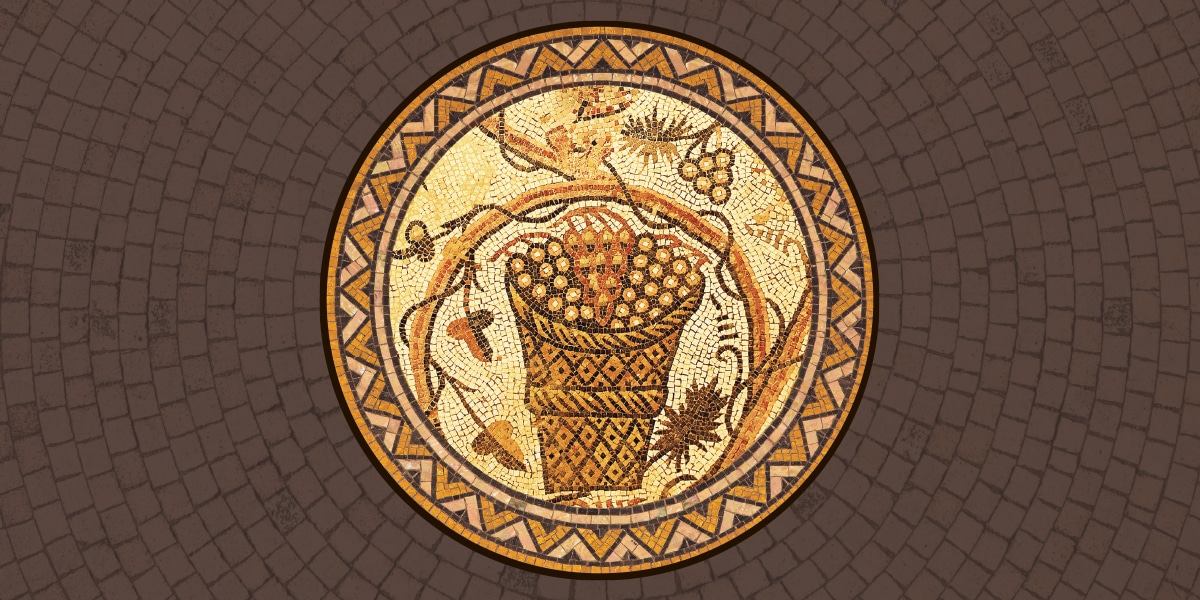The Bible provides a number of straightforward teachings about how a disciple of Jesus is to live, but there are less clear lessons too. Reading through the lens of the four senses of Scripture can help us better understand the Gospel and deepen our faith.
When the risen Christ appeared to his disciples on the first Easter, he made a curious remark: “Thus it is written that the Messiah would suffer and rise from the dead on the third day and that repentance, for the forgiveness of sins, would be preached in his name to all the nations, beginning from Jerusalem” (Lk 24:46–47).
The question that arises for attentive readers is “Where is that written in the Old Testament?” And this leads to a way of reading Scripture that was well known to the early Church and the Jewish culture from which it sprang but is often mysterious to modern readers.
It is called the four senses of Scripture.
St. Augustine sums up the four senses by saying that the New Testament is hidden in the Old Testament and the Old Testament is only fully revealed in the New.
The four senses are sketched by the Catechism of the Catholic Church in paragraphs 115–119. They are the literal, allegorical, moral, and anagogical senses, and understanding them can vastly enrich our appreciation of what the inspired authors are getting at in the rich tapestry of conversation across the Old and New Testaments.
The Literal Sense
The literal sense of Scripture refers to what the human author is trying to say, the way he is trying to say it, and what is incidental to the assertion (i.e., the “plain sense” of Scripture). When Matthew tells us, “Jesus was born in Bethlehem of Judea, in the days of King Herod” (Mt 2:1), he means what he says: That’s where and when Jesus was born.
It is tempting to conclude that there is not much to the literal sense, but this is not so, since getting at it can involve all sorts of literary analysis. For instance, one common mistake is confusing the literal sense with a flat-footed literalistic reading. To get at the distinction between the two, consider that when Jesus says, “I am the vine, you are the branches” (Jn 15:5), he has a literal meaning, but it is not “I am a grape plant.” Rather, he uses a vivid metaphor to communicate something he really does mean to say: namely, that the Christian disciple completely depends upon him for his life, just as the branch depends for its life on the vine. Huge swaths of Scripture use imagery to get across the writer’s literal sense.
One of the gravest dangers of reading for the literal sense is, as the following quote attributed to Josh Billings suggests: “It ain’t what you don’t know that gets you into the trouble. It’s what you know for sure that just ain’t so.” For instance, many people are sure that Genesis 1—2 is giving us bad science. But the reality is that Genesis is not giving us any sort of science; the authors have no interest in science. What they care about is the relationship of Israel to God and the way they see that relationship is in terms of temple liturgy. God is depicted as creating a sort of macrocosmic temple in the course of the creation week. The creatures mentioned in that narrative are not seen scientifically, but as rival gods to the God of Israel, all worshipped by Israel’s pagan neighbors. The point of the story is that these creatures—reptiles, fish, birds, the beasts of the fields—are good creatures of God, not gods themselves. And man and woman are made in the image and likeness of God.

This is why commentaries are so vital for getting at the literal sense of the text of Scripture: because they help us to understand the mindset of the original authors, living in a radically different culture, speaking a language few know today, thinking in categories foreign to us. Commentaries can help us grasp the meaning of actions and words strange to us and place them in context. They can give us information on such things as the author (if known), the relationship of the text to the historical situation of the time, the relationship between the author and his audience, and the relationship of the text we are reading to other biblical texts, since much of the New Testament is a commentary on the meaning of the Old Testament.
The key thing to understand about the literal sense of Scripture is that it is like the foundation of the house. If you don’t know, for instance, what the text in Exodus 12 says about the Passover sacrifice of the lamb in the deliverance of Israel from Egypt, you cannot possibly understand what John the Baptist means when he declares Jesus to be “the Lamb of God, who takes away the sin of the world” (Jn 1:29). And that brings us to the next sense of Scripture.
The Allegorical Sense
Early Christians saw God speaking, not just through words, but through things, historic events, weather, and all manner of symbols and imagery. That is why John the Baptist could see in the Passover lamb an image of Jesus. It is why Jesus could see the manna that God gave Israel during their wandering in the wilderness as an image of the Eucharist (Jn 6). It’s why Paul saw the passage through the Red Sea as an image of Baptism (1 Cor 10).
Again and again, the New Testament looks to the Old Testament, not for its literal sense, but for this allegorical sense. We read in Numbers 21 that when Israel rebelled against Moses in the wilderness, God permitted venomous snakes to invade the camp of Israel and inflict painful and deadly bites in punishment for that rebellion. We read that God instructed Moses to fashion a bronze serpent and hoist it up on a pole so that all who looked at it would be healed of snakebites.
The question that Israel would ponder for 13 centuries is not whether the story was true, but what it meant. What did the event signify?
When the Son of God finally arrives in the fullness of time, he declares to Israel not the literal sense of the story (they already know and believe that), but the meaning of the story, the allegorical sense of it:
“And just as Moses lifted up the serpent in the desert, so must the Son of Man be lifted up, so that everyone who believes in him may have eternal life” (Jn 3:14–15). Jesus’ point is that the bronze serpent is a prophetic image of himself, lifted up first on the cross and then in the resurrection and ascension to heal us of the ultimate snakebite, given in the Garden of Eden by “the ancient serpent, who is called the Devil and Satan” (Rv 12:9).
The allegorical sense is not something being foisted on the text, but something being read out of the text by people whose minds are steeped in the language and thought of the Old Testament. The New Testament writers, like any good writers immersed in a body of literature and marinated in its ideas and imagery, naturally draw from that rich pool of nutrients to nourish what they have to say. So, for instance, when Luke records Gabriel telling Mary that “the Holy Spirit will come upon you, and the power of the Most High will overshadow you” (Lk 1:35), he assumes that you, being a Jew or a gentile steeped in Jewish Scripture, will catch the allusion to the Shekinah Cloud of Glory that “overshadowed” the tabernacle and the Ark of the Covenant in the Old Testament and simply get that Mary is the new ark with the Lord dwelling, no longer in a golden box, but in her womb.
This is just a taste of this way of reading the Old Testament with apostolic eyes.
The Moral Sense
Jesus is very clear that, in the words of James, “a person is justified by works and not by faith alone” (Jas 2:24). Jesus tells his disciples that merely having a correct theological view of who he is while still refusing to obey him is useless:
“Not everyone who says to me, ‘Lord, Lord,’ will enter the kingdom of heaven, but only the one who does the will of my Father in heaven. Many will say to me on that day, ‘Lord, Lord, did we not prophesy in your name? Did we not drive out demons in your name? Did we not do mighty deeds in your name?’ Then will I declare to them solemnly, ‘I never knew you. Depart from me, you evildoers’” (Mt 7:21–23).
This being the case, we must learn from Scripture how to act as Jesus would have us act, not merely to believe things about Jesus. Jesus said we would be judged according to the way we acted, because what we do is the sign of what we truly believe. That is what the parable of the sheep and the goats (Mt 25:31–46) is all about.

Of course, a lot of the moral sense of Scripture is plain and didactic. Things like the Ten Commandments and the Sermon on the Mount tell us an awful lot of straightforward teaching about how a disciple of Jesus is to live. And there are many models of various heroes and saints in both the Old and New Testaments. As Paul says, “Be imitators of me, as I am of Christ” (1 Cor 11:1). In a similar vein, Hebrews 11 throws out for our inspection a big list of Old Testament heroes from whom we can learn various qualities of virtue.
But in addition to this, early Christians saw various images of the moral life hidden in Scripture.
A classic example is the Temple. In its literal sense, of course, the Temple was a big stone building reserved for the worship of God. In its allegorical sense, Jesus made clear that it was a sign pointing to his body. That is why he said, “Destroy this temple and in three days I will raise it up” (Jn 2:19).
When Paul is writing moral instruction to the Corinthian Church, he has no problem telling those fornicating, “Do you not know that your body is a temple of the Holy Spirit within you, whom you have from God, and that you are not your own? For you have been purchased at a price. Therefore, glorify God in your body” (1 Cor 6:19-20). The temple is thus given a moral sense to which the Church will turn again and again for the next two millennia.
And that brings us to the final sense.
The Analogical Sense
This $3 word refers to our destiny in Christ. The entire goal of the Christian faith is that we share forever in the divine life of the Holy Trinity as risen and glorified human beings in the new heaven and the new earth. Paul tells us to “think of what is above, not of what is on earth” (Col 3:2). Accordingly, the early Christians read (and wrote) their Scriptures to reflect their faith in the four last things: death, judgment, heaven, and hell.
When Joseph is thrown into a pit, sold into slavery, and finally ends up in prison—only to be saved, raised to the King’s right hand, and exalted to such a degree that he becomes the source of life to the very family that betrayed and rejected him (Gn 37–50)—the embattled and persecuted early Church read this not only in the allegorical sense as referring to the death and resurrection of Jesus, but as a picture of our destiny. “For you have died, and your life is hidden with Christ in God. When Christ your life appears, then you too will appear with him in glory” (Col 3:3–4).
Similarly, Jesus takes a real place—the Valley of Hinnom south of Jerusalem—and gives it an anagogical sense to warn of the destiny of those who refuse to obey his Gospel. The place was seen as accursed and forsaken because it had been used for child sacrifice in the worship of Moloch centuries earlier. By the time of Christ, it was known by the Greek word Gehenna, which English translations of Scripture commonly render as “hell.”
Likewise, when the authors of Hebrews and Revelation look at the city of Jerusalem, they see the image of our heavenly destiny. Hebrews 12:22 tells believers “you have approached Mount Zion and the city of the living God, the heavenly Jerusalem,” while Revelation climaxes with similar imagery as the seer speaks of “the holy city Jerusalem coming down out of heaven from God” (Rv 21:10).
All these are merely tastes of how the four senses have been used throughout Scripture. The Fathers of the Church continue this tradition in all its richness, as does the devotional tradition of the Church. From Augustine using the image of Jerusalem to write his City of God to Dante’s Divine Comedy to American abolitionists drawing on Exodus for their anti-slavery work to a host of other applications, the four senses inform the way we read the Bible constantly and make it vastly more abundant and fruitful.
The next time you go to Mass, pay attention to the way the Old Testament reading often anticipates the Gospel reading or the Gospel comments on the Old Testament. When you read Scripture, follow the cross-references that point you somewhere else in the Bible. That’s no accident. It’s all part of the great conversation that is the biblical tradition. And we are part of it, even today. Join in!








